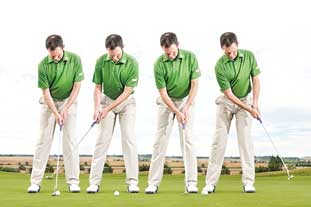Mastering The Art Of Putting
By Chris Foley
Over the course of the season, in each issue of Tee Times we will cover an aspect of putting in this column. Becoming a great putter is part of the game that doesn’t require exceptional athletic ability, great club head speed, or a great deal of time and energy. It is the area of the game were the average player can be of similar skill level to the elite level player. With the right information and with a commitment to practice your putting you will improve, and your scores will get better!
We can break putting into the following areas; the set-up, stroke mechanics, distance control, and green reading.
This month we are going to focus on distance control.
Distance control is the most important element in putting. With good distance control a higher percentage of makeable putts are made, and the chance of three putting is greatly reduced.
The first element of good distance control is hitting the golf ball in the center of the club face. It is difficult to calibrate your stroke if you are inconsistent in hitting the ball in the center of the face.
The second element is the length and the pace of the stroke. As we get further away from the hole, the stroke should get bigger and the pace faster. Closely related to this is the shape or symmetry of the stroke. The length of the back swing and the forward swing of the best putters are very similar. If the back swing is six inches the length of the forward swing past impact should also be six inches.
The final element of good distance control is the tempo and timing of the stroke. Good tempo in the putting stroke is 2:1 ratio. The back swing should take twice as much time as the forward stroke. The time element of the stroke is dependent on the length of the putt, but the tempo should remain the same. For example, if the back swing is .7 seconds the forward swing would be .35 seconds.
By focusing on these elements and practicing distance control, your opportunity for great putting will be greatly enhanced!






























